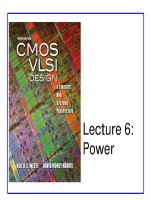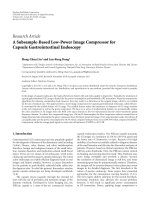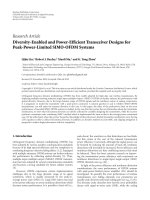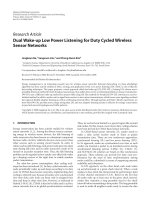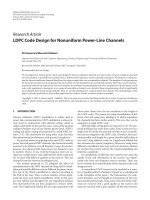Design for Low Power potx
Bạn đang xem bản rút gọn của tài liệu. Xem và tải ngay bản đầy đủ của tài liệu tại đây (176.34 KB, 24 trang )
Introduction to
CMOS VLSI
Design
Design for Low Power
Design for Low PowerSlide 2
CMOS VLSI Design
Outline
Power and Energy
Dynamic Power
Static Power
Low Power Design
Design for Low PowerSlide 3
CMOS VLSI Design
Power and Energy
Power is drawn from a voltage source attached to
the V
DD
pin(s) of a chip.
Instantaneous Power:
Energy:
Average Power:
( ) ( )
DD DD
P t i t V=
0 0
( ) ( )
T T
DD DD
E P t dt i t V dt= =
∫ ∫
avg
0
1
( )
T
DD DD
E
P i t V dt
T T
= =
∫
Design for Low PowerSlide 4
CMOS VLSI Design
Dynamic Power
Dynamic power is required to charge and discharge
load capacitances when transistors switch.
One cycle involves a rising and falling output.
On rising output, charge Q = CV
DD
is required
On falling output, charge is dumped to GND
This repeats Tf
sw
times
over an interval of T
C
f
sw
i
DD
(t)
VDD
Design for Low PowerSlide 5
CMOS VLSI Design
Dynamic Power Cont.
C
f
sw
i
DD
(t)
VDD
dynamic
P =
Design for Low PowerSlide 6
CMOS VLSI Design
Dynamic Power Cont.
C
f
sw
i
DD
(t)
VDD
[ ]
dynamic
0
0
sw
2
sw
1
( )
( )
T
DD DD
T
DD
DD
DD
DD
DD
P i t V dt
T
V
i t dt
T
V
Tf CV
T
CV f
=
=
=
=
∫
∫
Design for Low PowerSlide 7
CMOS VLSI Design
Activity Factor
Suppose the system clock frequency = f
Let f
sw
= αf, where α = activity factor
–
If the signal is a clock, α = 1
–
If the signal switches once per cycle, α = ½
–
Dynamic gates:
•
Switch either 0 or 2 times per cycle, α = ½
–
Static gates:
•
Depends on design, but typically α = 0.1
Dynamic power:
2
dynamic DD
P CV f
α
=
Design for Low PowerSlide 8
CMOS VLSI Design
Short Circuit Current
When transistors switch, both nMOS and pMOS
networks may be momentarily ON at once
Leads to a blip of “short circuit” current.
< 10% of dynamic power if rise/fall times are
comparable for input and output
Design for Low PowerSlide 9
CMOS VLSI Design
Example
200 Mtransistor chip
–
20M logic transistors
•
Average width: 12 λ
–
180M memory transistors
•
Average width: 4 λ
–
1.2 V 100 nm process
–
C
g
= 2 fF/µm
Design for Low PowerSlide 10
CMOS VLSI Design
Dynamic Example
Static CMOS logic gates: activity factor = 0.1
Memory arrays: activity factor = 0.05 (many banks!)
Estimate dynamic power consumption per MHz.
Neglect wire capacitance and short-circuit current.
Design for Low PowerSlide 11
CMOS VLSI Design
Dynamic Example
Static CMOS logic gates: activity factor = 0.1
Memory arrays: activity factor = 0.05 (many banks!)
Estimate dynamic power consumption per MHz.
Neglect wire capacitance.
( )
( ) ( ) ( )
( )
( ) ( ) ( )
( )
6
logic
6
mem
2
dynamic logic mem
20 10 12 0.05 / 2 / 24
180 10 4 0.05 / 2 / 72
0.1 0.05 1.2 8.6 mW/MHz
C m fF m nF
C m fF m nF
P C C f
λ µ λ µ
λ µ λ µ
= × =
= × =
= + =
Design for Low PowerSlide 12
CMOS VLSI Design
Static Power
Static power is consumed even when chip is
quiescent.
–
Ratioed circuits burn power in fight between ON
transistors
–
Leakage draws power from nominally OFF
devices
0
1
gs t
ds
T T
V V
V
nv v
ds ds
I I e e
−
−
= −
( )
0t t ds s sb s
V V V V
η γ φ φ
= − + + −
Design for Low PowerSlide 13
CMOS VLSI Design
Ratio Example
The chip contains a 32 word x 48 bit ROM
–
Uses pseudo-nMOS decoder and bitline pullups
–
On average, one wordline and 24 bitlines are high
Find static power drawn by the ROM
–
β = 75 µA/V
2
–
V
tp
= -0.4V
Design for Low PowerSlide 14
CMOS VLSI Design
Ratio Example
The chip contains a 32 word x 48 bit ROM
–
Uses pseudo-nMOS decoder and bitline pullups
–
On average, one wordline and 24 bitlines are high
Find static power drawn by the ROM
–
β = 75 µA/V
2
–
V
tp
= -0.4V
Solution:
( )
2
pull-up
pull-up pull-up
static pull-up
24μA
2
29μW
(31 24) 1.6 mW
DD tp
DD
V V
I
P V I
P P
β
−
= =
= =
= + =
Design for Low PowerSlide 15
CMOS VLSI Design
Leakage Example
The process has two threshold voltages and two
oxide thicknesses.
Subthreshold leakage:
–
20 nA/µm for low V
t
–
0.02 nA/µm for high V
t
Gate leakage:
–
3 nA/µm for thin oxide
–
0.002 nA/µm for thick oxide
Memories use low-leakage transistors everywhere
Gates use low-leakage transistors on 80% of logic
Design for Low PowerSlide 16
CMOS VLSI Design
Leakage Example Cont.
Estimate static power:
Design for Low PowerSlide 17
CMOS VLSI Design
Leakage Example Cont.
Estimate static power:
–
High leakage:
–
Low leakage:
( )
( ) ( ) ( )
6 6
20 10 0.2 12 0.05 / 2.4 10m m
λ µ λ µ
× = ×
( )
( ) ( ) ( )
( )
( ) ( )
6
6 6
20 10 0.8 12 0.05 /
180 10 4 0.05 / 45.6 10
m
m m
λ µ λ
λ µ λ µ
× +
× = ×
( )
( ) ( )
( )
( ) ( )
6
6
2.4 10 20 / / 2 3 /
45.6 10 0.02 / / 2 0.002 /
32
38
static
static static DD
I m nA m nA m
m nA m nA m
mA
P I V mW
µ µ µ
µ µ µ
= × + +
× +
=
= =
Design for Low PowerSlide 18
CMOS VLSI Design
Leakage Example Cont.
Estimate static power:
–
High leakage:
–
Low leakage:
If no low leakage devices, P
static
= 749 mW (!)
( )
( ) ( ) ( )
6 6
20 10 0.2 12 0.05 / 2.4 10m m
λ µ λ µ
× = ×
( )
( ) ( ) ( )
( )
( ) ( )
6
6 6
20 10 0.8 12 0.05 /
180 10 4 0.05 / 45.6 10
m
m m
λ µ λ
λ µ λ µ
× +
× = ×
( )
( ) ( )
( )
( ) ( )
6
6
2.4 10 20 / / 2 3 /
45.6 10 0.02 / / 2 0.002 /
32
38
static
static static DD
I m nA m nA m
m nA m nA m
mA
P I V mW
µ µ µ
µ µ µ
= × + +
× +
=
= =
Design for Low PowerSlide 19
CMOS VLSI Design
Low Power Design
Reduce dynamic power
–
α:
–
C:
–
V
DD
:
–
f:
Reduce static power
Design for Low PowerSlide 20
CMOS VLSI Design
Low Power Design
Reduce dynamic power
–
α: clock gating, sleep mode
–
C:
–
V
DD
:
–
f:
Reduce static power
Design for Low PowerSlide 21
CMOS VLSI Design
Low Power Design
Reduce dynamic power
–
α: clock gating, sleep mode
–
C: small transistors (esp. on clock), short wires
–
V
DD
:
–
f:
Reduce static power
Design for Low PowerSlide 22
CMOS VLSI Design
Low Power Design
Reduce dynamic power
–
α: clock gating, sleep mode
–
C: small transistors (esp. on clock), short wires
–
V
DD
: lowest suitable voltage
–
f:
Reduce static power
Design for Low PowerSlide 23
CMOS VLSI Design
Low Power Design
Reduce dynamic power
–
α: clock gating, sleep mode
–
C: small transistors (esp. on clock), short wires
–
V
DD
: lowest suitable voltage
–
f: lowest suitable frequency
Reduce static power
Design for Low PowerSlide 24
CMOS VLSI Design
Low Power Design
Reduce dynamic power
–
α: clock gating, sleep mode
–
C: small transistors (esp. on clock), short wires
–
V
DD
: lowest suitable voltage
–
f: lowest suitable frequency
Reduce static power
–
Selectively use ratioed circuits
–
Selectively use low V
t
devices
–
Leakage reduction:
stacked devices, body bias, low temperature

